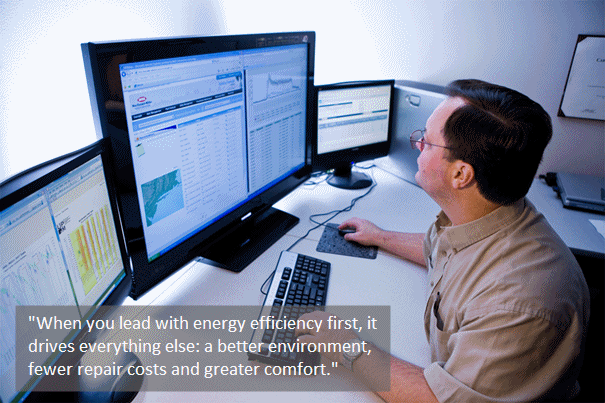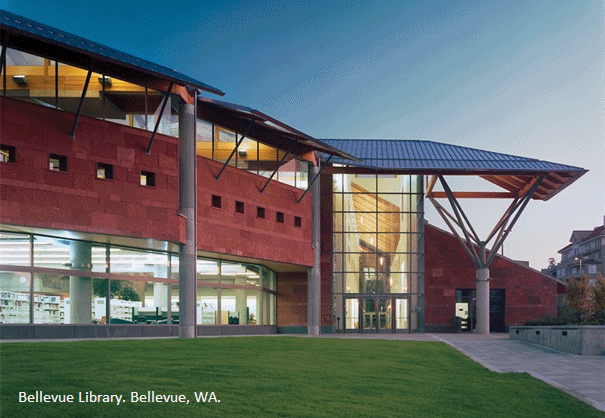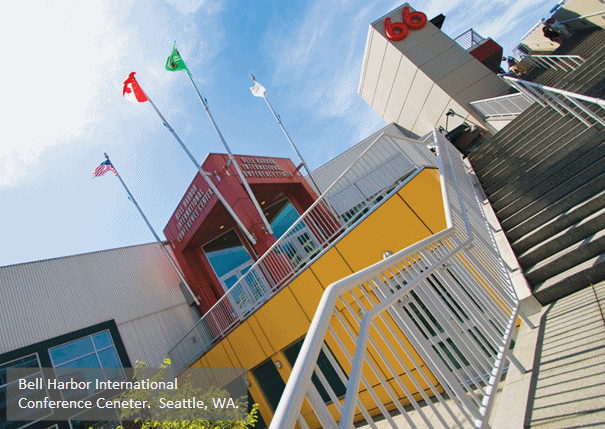With a winning formula for success, MacDonald-Miller is one of the Northwest's premier mechanical contractors. Always looking for new ways to help their customers be successful, MacDonald-Miller decided to shift their focus to "energy first." The result is tremendous energy savings for their customers and a healthy revenue stream for the company.
New opportunity inspires a novel strategy
MacDonald-Miller has always been dedicated to meeting their customers' needs, whether it's construction-related engineering, building maintenance or capital equipment replacement. In recent years they have identified another opportunity with enormous potential: use these same services to help customers fine tune their buildings to run as efficiently as possible and save money.
Leveraging their core competencies, MacDonald-Miller made energy savings the top priority in all their projects. Their objective was to make each building perform at optimum efficiency. As a result, their customers are seeing impressive benefits:
- Significant savings in energy costs.
- Reduced repair costs.
- Increased comfort for tenants and occupants.
- Fewer comfort complaints.
Gus Simonds, president of the company, realized that to achieve this goal of peak performance in every building, MacDonald-Miller would need to add new skills. So he hired Perry England to create and run the Building Performance Services Group. They brought on highly skilled, experienced engineers who could work across all three profit centers-Construction, Service and Special Projects-to develop optimal solutions for their customers' buildings. They reorganized the infrastructure of their personnel to better align skill sets and create groups that could cross-collaborate and learn from each other. They trained their technicians in the latest technology. They oriented their sales staff to focus on "energy first" in their presentations. The result is a seamlessly integrated team with a single focus: high performance buildings.
Taking a novel approach to the market, MacDonald-Miller focuses on building tune-ups before pursuing large retrofit and capital investment projects. Their first priority is to improve the operations and programming logic so the building runs at peak performance. It's a strategy that consistently results in significant savings for their customers.
MacDonald-Miller's track record with this approach speaks for itself:
- Two high rises in the Seattle area achieved over $100,000 in avoided costs over an 8-month period. During the coldest winter in 30 years, their energy bill actually went down.
- A building in Tumwater, WA saw a 36% decrease in gas energy consumption in the first month.
- Another building in Seattle reduced its energy bill by 40% in one and a half years by simply optimizing their existing systems.
- In Federal Way, WA, owners of a 105,000 sq. ft. building realized 50% ROI on their investment in the first year. It is projected to reach 135% at the end of their 3-year contract.
- One building in Seattle had an ENERGY STAR rating of 99. Not satisfied, MacDonald-Miller tuned the systems through programming changes and saved the owner $145,000 over the next year. It was the first high rise in the country to score an ENERGY STAR rating of 100.

Once building owners start seeing results like these, they get excited about looking for other opportunities to reduce their energy consumption. Some hire MacDonald-Miller to replicate these energy saving measures in other buildings. Others use the money they save to fund larger capital investment projects that will bring even more savings down the road. In both cases, MacDonald-Miller generates additional "pull-through" business and their customers end up very happy.
A shift in culture generates creative solutions
More than just a change in the org chart, MacDonald-Miller's approach represents a shift in thinking. Now when they respond to a repair call they look at the building as a whole. "Fundamentally, it's a change in how we walk into a building," says Perry England, Vice President of Building Performance. "We are always looking for more ways to help our customers be successful."
This focus on energy also influences the type of buildings MacDonald-Miller seeks out. Surprisingly, it's not just the older buildings that have potential for savings. "It sounds counter-intuitive," says Dave Nieman, "but the better the building operates, the more opportunity there is. When you have an inefficient building, it's working against itself. Incremental changes get erased because the systems are competing with each other." When a building is well-tuned, those incremental changes can have a big impact.
The utilities agree with the value of performance-based building maintenance. Puget Sound Energy recently revamped its Building Optimization Program to include incentives for sustaining and improving building performance over time.
Bringing customers on board
Educating customers about the value of energy efficiency presents its own set of challenges. Historically, energy prices in the Northwest have been so low that efficiency hasn't been a big concern. This is changing, however, as the current economy puts a squeeze on building owners and savings of any kind become more attractive. Increasing environmental awareness is also helping make energy efficiency more of a priority as people in all fields realize the need to take concrete steps for the health of the environment.

The other challenge in educating customers is that there are actually three groups that need to buy in to the idea. Each comes to the table with its own agenda, needs and concerns:
- Building owners: With owners, MacDonald-Miller explains how, with little investment, they can start saving money on their energy costs and lengthen the life of their equipment. In a tight economy, this is good news to any owner-spending a dollar towards energy savings will pay back many times compared to doing nothing.
- Property managers: To address the property managers' concerns, MacDonald-Miller describes how energy efficiency can actually make it easier to attract and retain tenants. A well-tuned building translates into lower utility rates for tenants, a more comfortable building and better indoor air quality.
- Tenants: MacDonald-Miller also works with tenants to show how, without affecting their budget, they can have a better, healthier, more comfortable building that has less impact on the environment.
It's a process that takes time and patience. But MacDonald-Miller knows that once people understand the benefits of efficiency, they are quite willing to take advantage of the opportunity for savings.
Embracing technology for greater benefit
Technology has played a big role in MacDonald-Miller's success and will continue to do so. The utiliVisor™ tool they use to manage and verify the operation of their customers' buildings, provides instant feedback on the building's performance. No more waiting 30 days for the energy bill to arrive to find out if the system adjustments were effective. Now technicians can see at a glance the effects of their modifications on system performance.

Educating customers is a high priority for MacDonald-Miller. Using data visualization tools they can present the information to the customer in a way that visually shows the effect of certain actions. This helps building managers, tenants and janitors alike see how their behaviors affect the building's performance.
MacDonald-Miller is also investigating and adopting emerging technologies:
- Submetering. Quite common on the East Coast, submetering is starting to gain traction in the Northwest. Tools such as the utiliVisor™ provide the means to submeter utilities so tenants are only charged for their actual usage rather than a prorated amount based on square footage.
- Lighting technologies. Today most manufacturers are putting their research dollars into LED technology rather than fluorescents. MacDonald-Miller is already preparing their staff to be ready to retrofit buildings when LED technology becomes a viable business option from a life cycle perspective.
- HVAC systems. While some development in this area is dictated by code and federal mandate, many manufacturers are also innovating to compete with one another in the marketplace. MacDonald-Miller continually invests in training their staff so they can advise their customers about the best products to use.
- Building automation. MacDonald-Miller trains their staff to work with web-based systems, multiple protocols and open database structures so they can drive building performance to optimal levels.
A view to the future
As the world grapples with its energy needs, trends in the marketplace continue to drive business decisions regarding energy. MacDonald-Miller's focus on efficiency places it in the perfect position to respond to these trends.
- A Carbon Tax, at both the state and federal levels, will get people's attention. As MacDonald-Miller has proven, energy efficiency is the least costly investment for lowering a building's carbon footprint.
- Legislation around ENERGY STAR rating disclosures will have a big impact on building owners, providing tenants with more information for choosing a building. Owners will be competing with each other to improve their buildings' energy use.
- Renewable energy use is another upward trend and a place where MacDonald-Miller shines. With the money customers save from energy efficiency, they are now able to invest in systems that increase their energy independence. A large part of MacDonald-Miller's capital investment and retrofit projects involve installing renewable energy systems such as:
- ground source heat pumps
- geothermal systems
- solar systems
- wind
- microturbines
- fuel cell technology
Leading the charge
With its innovative spirit and portfolio of successes, MacDonald-Miller is on the leading edge of a paradigm shift in the industry. Even in a tight economy of slim budgets and reduced staff, there are hidden opportunities for savings right behind the equipment room door. It doesn't take a big capital investment to save energy. Very often just optimizing a building's existing systems can make a big difference, as MacDonald-Miller has proven over and over again.
